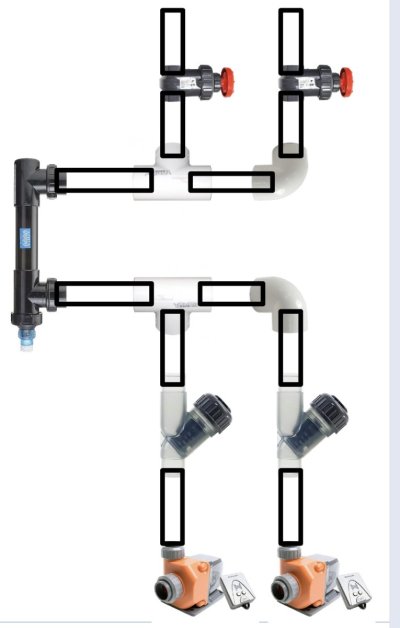The tanks I’m looking at are as follows:
Primary Display: 74 gallon
Secondary Crab Display: 17.1 gallon
Sump: Trigger Systems Platinum 20 cube
If money were no object, it would appear the wise thing to do would be to have 4 return pumps, so that each display had its own discrete set of two, hence having redundancy. Also, if I were attempting to keep plumbing to a minimum, having two return pumps, one solely responsible for each display tank, would prove to have the least complex design.
Id like to build my system with some redundancy but also not completely break the bank. Here’s what I have in mind:
from the sump, two Neptune Cor 20s. Each has a check valve. That feeds into one shared tubing system. The water from both is then moved into a UV sterilizer. From there, the singular tube is split off using gate valves(?), so that the flow is appropriately distributed for the large vs the small tank.
ive included a rudimentary image. I will likely add in unions for the ability to disconnect to clean, and maybe some Neptune apex flow
Is this viable?
I’m wondering if this can provide to both tanks while having the redundancy of a multi return pump system.
can I feasibly use valves to distribute flow so that my larger tank is receiving significantly higher flow than the smaller tank? Based on the 10x rule as well as the fact that I’d be keeping coral in the larger tank, I’d imagine I’d need about 1100 GPH for the larger tank (increase from 740 to account for extra flow for corals) and about 200 gph. for the smaller one.
also, each cor 20 produces 2000 GPH, but I’m aware that having junctions, elbows, check valves, etc reduces head pressure. Between the two cor 20s and all this plumbing, will I be left with enough power to keep both tanks turning over properly?
Primary Display: 74 gallon
Secondary Crab Display: 17.1 gallon
Sump: Trigger Systems Platinum 20 cube
If money were no object, it would appear the wise thing to do would be to have 4 return pumps, so that each display had its own discrete set of two, hence having redundancy. Also, if I were attempting to keep plumbing to a minimum, having two return pumps, one solely responsible for each display tank, would prove to have the least complex design.
Id like to build my system with some redundancy but also not completely break the bank. Here’s what I have in mind:
from the sump, two Neptune Cor 20s. Each has a check valve. That feeds into one shared tubing system. The water from both is then moved into a UV sterilizer. From there, the singular tube is split off using gate valves(?), so that the flow is appropriately distributed for the large vs the small tank.
ive included a rudimentary image. I will likely add in unions for the ability to disconnect to clean, and maybe some Neptune apex flow

Is this viable?
I’m wondering if this can provide to both tanks while having the redundancy of a multi return pump system.
can I feasibly use valves to distribute flow so that my larger tank is receiving significantly higher flow than the smaller tank? Based on the 10x rule as well as the fact that I’d be keeping coral in the larger tank, I’d imagine I’d need about 1100 GPH for the larger tank (increase from 740 to account for extra flow for corals) and about 200 gph. for the smaller one.
also, each cor 20 produces 2000 GPH, but I’m aware that having junctions, elbows, check valves, etc reduces head pressure. Between the two cor 20s and all this plumbing, will I be left with enough power to keep both tanks turning over properly?












